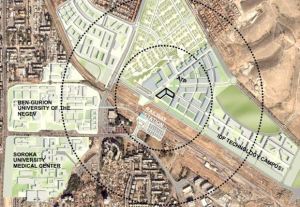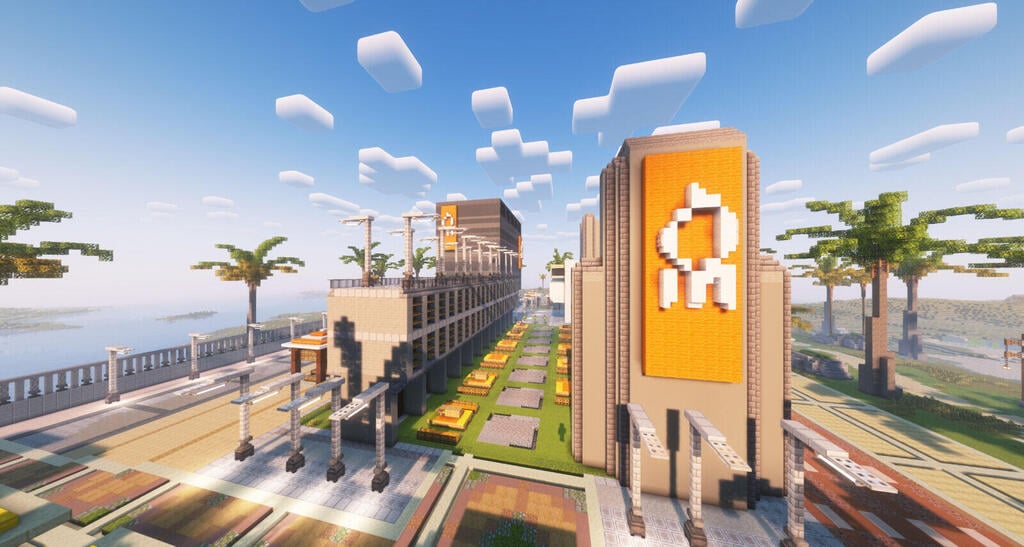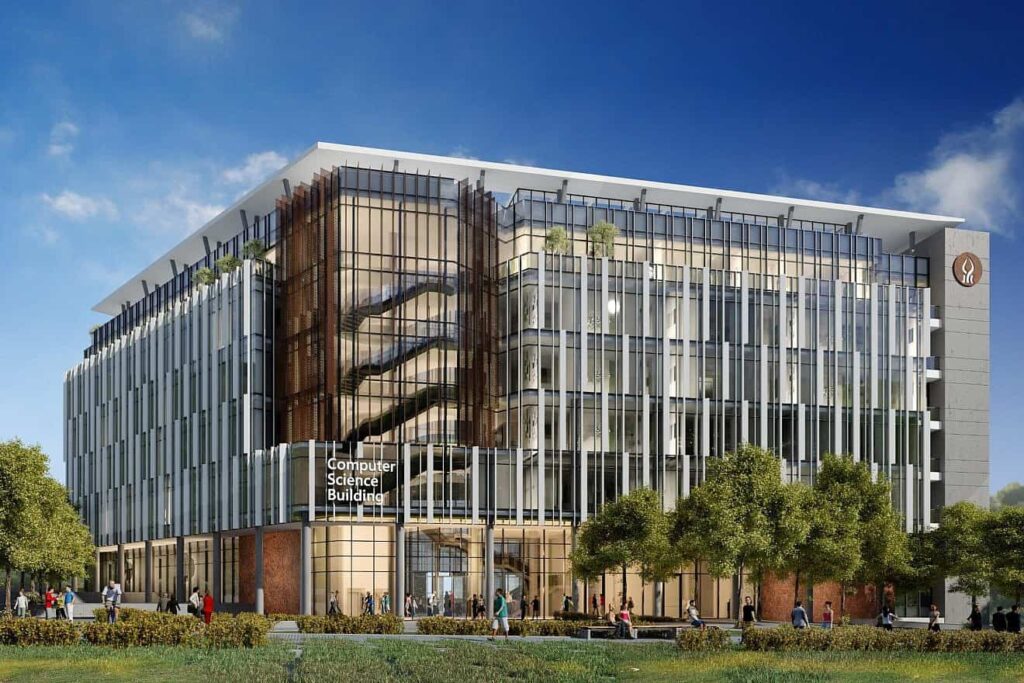
Negev Bonanza
August 8, 2014
Negev Development & Community Programs, Robotics & High-Tech
The Jerusalem Report — The biggest project the state has ever known gets underway with the planned transfer of IDF bases and personnel to the south.
The massive relocation of the Israel Defense Forces facilities to the south, long planned and promised, has now reached an impressive momentum.
At the same time, multinational companies are moving into the brand new Advanced Technologies Park (ATP) in Beer-Sheva, promising to transform the former backwater capital of the Negev into a global cyber capital. Concurrently, the Trans-Israel Highway (Road 6) and rail networks are being extended at an unprecedented pace.
This accelerated development is expected to provide a major boost to the economy of the Negev, which most Israelis still regard as the rural periphery. Decades of underdevelopment and unfulfilled promises of investment in the arid region, which accounts for almost two-thirds of the country’s land but just eight percent of its population, are clearly coming to an end.
Idealistic language figures prominently when officials connected to the project describe the move to the Negev. A “national project” they call it, “in the spirit of Ben- Gurion’s vision of making the Negev flourish.”
While no academic studies have been carried out on the economic impact of the multibillion shekel project, which officials say is the biggest the state has ever known, it already is providing a boost to the local economy.
Beginning at the end of the year, the IDF will start moving major military installations from the densely populated center of the country to the Negev. The relocation is designed to streamline combat support training – now carried out in multiple facilities in the extremely congested Tel Aviv-area heartland – by funneling it into a single site.
Eight separate IDF training bases now located in several British Mandate-era army camps in the center will be relocated to the country’s first mega base at the Negev Junction, 20 kilometers (12 miles) south of Beer-Sheva.
Also, in the next few years, the IDF will transfer the core of its technological weight to the south – Intelligence Branch facilities will be moved from affluent Ramat Hasharon to a base to be built at the Shoket Junction, just north of Beer-Sheva, and the C4I Communications Corps will be transferred from Tel Aviv to a base to be constructed next to Beer-Sheva’s Ben-Gurion University of the Negev (BGU), allowing the IDF to decentralize its vulnerable security structure.
Two smaller training camps also will be relocated to Beer-Sheva, and the Air Force has already moved two of its bases to the Negev; most recently the IAF base alongside Ben-Gurion Airport shifted to Nevatim, near Arad.
There are already several major military bases in the south, like the Nevatim base relocated from the Sinai after the agreement with Egypt, and Tze’elim, set up in the 1960s.
But the moves were gradual, without the massive amount of construction going on now, or the central concentration of bases and personnel. There are some career soldiers and their families living in the south, but they moved independently and are scattered throughout different communities.
Originally called Training Base City, the massive military complex now under construction has been officially designated the Ariel Sharon IDF Combined Instructional Center, named after the late prime minister, the main mover in getting the project approved for the Negev.
Just two years ago, the site designated for the mammoth new training base, located near the town of Yeruham and not far from Dimona‘s Nuclear Research Center, was a desert wilderness. Today, the 2,500-dunam (632 acre) site, which is bisected by the Zin Valley, is an entire city under construction with cranes and earth-moving equipment everywhere. This is a hard hat-only zone, as building is carried out at a feverish, around-the-clock pace.
Among the training divisions due to be moved to the new facility are the Medical Corps, Armaments and Maintenance, Education, Logistics, Manpower, and the Military Police Academy. So far, the police station is the only completed building.
When completed and fully occupied, the mega base will house 10,000 army personnel along with a support staff of 500 civilians, making it the Negev’s third-largest population center after Dimona and Beer-Sheva, albeit one in which there will be a constant turnover of the population.
The mainly pedestrian complex will include training centers with hundreds of computerized classrooms and simulation sites, a hospital and clinic, dormitories, sports centers, three synagogues, a conference center, and shopping center. Just outside the perimeter of the camp, a recreational public park is planned, funded by the Jewish National Fund (JNF), which will include a hotel.
New bridges constructed over the wadi are designed to support the army’s heaviest tanks.
The base abuts nature reserves but, according to Col. Danny Moshoyov, commander of the new military complex, the existing firing ranges are being reorganized, not expanded as some Desert & Water Researchalist groups charge, thus leaving the available area for tourism intact.
Moshoyov shows visitors an animated film simulation of the completed base. Lush vegetation covers the banks of a man-made stream running through the complex. Benches and a cycling path overlook the stream making the site look more like a resort or college campus than an army base.
“Everything is being built to the highest standards. Our main aim is to run these training courses at the highest level possible,” Moshoyov relates to The Jerusalem Report.
As the vast military complex rises from the sand, the economic impact of the project is already being felt. Moshoyov echoes the missionary tone of other officials in describing the effect of the massive project as “the realization of Ben-Gurion’s vision. This has national importance, as the state strengthens the residents of the south with infrastructure and employment.”
A key to this mega project is the use of a private company (a Public-Private Partnership, or “PPP”), as was the case for the construction of Trans-Israel Highway 6, but is the first time this has been used by the military. Mabat laNegev (View to the Negev), a consortium of four companies formed specifically for this project, won a 25-year contract to build and operate the military training complex.
The project already has meant an infusion of jobs into the south, particularly in construction, with Mabat laNegev responsible for all the subcontractors. Most of the 1,400 workers on the site have been hired locally (no foreign workers) and, indirectly, another 2,000 workers, employed in various plants and factories in the area, supply materials.
Ackerstein Paving Stones, with a factory in Yeruham, has tripled its output in the last year, relates Moshoyov. “We’ve insisted that Negev companies get preferential consideration for jobs. We also plan to hire civilian instructors for the training courses, not just career officers,” he says.
The estimated total cost of the training complex together with the intelligence and communications bases is 22 billion shekels ($6.3 billion). Estimates for all the projects involved in the transition to the Negev are closer to $11 billion. Where is the money coming from? The Defense Ministry has been promoting the project to prospective international investors and even overseas benefactors. The sports center at the training base, for example, is being funded by American-Jewish donors.
But the bulk of the money will come from the sale of state-owned lands in the densely populated center, where various military camps and installations are currently located.
This is some of the country’s priciest and most sought-after real estate. The sale of the lands is expected to earn the state tens of billions of shekels, half of which is to go directly to the Treasury, which in turn will sell the areas to developers.
Today, it is more expensive to buy an apartment in some parts of Tel Aviv than Manhattan, and the government is under pressure to stem the rise in housing prices.
Thus, the IDF move to the south will serve not only the government’s declared goal to develop the Negev, but will also free up land for housing in the center. The Construction and Housing Ministry estimates 35,000 apartments, including about 9,000 classified as “affordable housing,” will be built on the emptied sites, although “affordable” seems a remote possibility given the constant rise in housing prices.
Meanwhile, military personnel to be relocated from the center to the Negev must be accommodated. While the 9,500 soldiers in the regular army coming to the mega training base for three-month courses will be housed in dormitories, another 500 or so career officers and their families could be persuaded – if the army’s promotional efforts succeed – to buy private homes in the area.
In the next five years, some additional 30,000 army personnel will also be moved to serve in the new bases in the Beer-Sheva area.
Although it soon will be even easier to get to the Negev by car or train, Hezi Mashita, formerly a high-ranking officer in the navy and now the Defense Ministry’s administration chief in the Negev, says, “We don’t want these career officers and NCOs commuting back and forth to Tel Aviv. We want them to live near the bases; it’s good for us and it’s efficient.”
In fact, the anticipated move of army personnel to the south has already set off a building boom in the area. It comes at a time of renewed emphasis by the government to bring residents to this region.
The chief benefactors of all this activity, so far, seem to be the building contractors who have won tenders for the construction of housing units being marketed specifically to army officers. In Beer-Sheva, two new neighborhoods are already in an advanced stage of preparation. Construction in nearby bedroom communities, such as Meitar and Omer, has dramatically increased.
Yeruham, just a 10-minute drive from the enormous new training base, has been plugging a project of private homes called Tzahala – the same name as the northern Tel Aviv neighborhood originally set up to house the military brass of a previous generation.
(After houses built in Omer with favorable terms for officers a few years ago were immediately sold or sublet to non-military people, this time, purchasers of the new housing units must agree to live there for at least five years, with no option to rent or sell.)
But even with all the real-estate activity already going on and the opportunity for career officers to build relatively large detached houses for the price of small apartments in the center, the army is facing a tough battle to persuade them to move south with their families.
“Most of the military professionals live in the center and to convince them to move to the periphery is a big change and, for us, a big risk,” Mashita, tells The Report. “If we build the bases and lose the manpower, it’s better to stay in Tel Aviv.”
The Defense Ministry is now actively trying to tempt career soldiers to move south by offering a wide range of benefits and incentives, including mortgages, rent subsidies, salary boosts, assistance for spouses in finding jobs, and moving expenses. The army even puts on organized tours of the region.
In a film produced by the army shown at a recent recruitment gathering, the announcer says, “You probably think we’ll tempt you with a detached house and a swimming pool waiting for you, or at least a barbecue.
“But we’ll show you what’s really available, whether a one-room apartment or a villa. The Negev offers a young, fun social life, academic studies, and lots of freedom,” declares the voiceover.
Speaking at the meeting, Yeruham Mayor Michael Biton commented that “Building houses isn’t the problem. The challenge is making people want to live here. This means investing in education and many other things like jobs for the spouses of military personnel who arrive.”
“A lot depends on accessibility, quality of life, real opportunities in education, culture and employment offered to the officers’ families, most of whom are not keen to relocate to the south,” says Prof. David Newman, dean of BGU’s Faculty of Humanities and Social Sciences.
Mashita, in charge of the relocation of civilian infrastructure, explains he’s been trying to harness as many sources as possible to expand opportunities for career soldiers and their families relocating south when the time comes.
“I’m in touch with all the mayors and civilian industries and organizations in the south, and coordinating with all the ministries so they’ll upgrade the infrastructure in the Negev,” he says in an interview at his office in the brand new Defense Ministry building in Petah Tikva, just east of Tel Aviv.
Shmuelik Rifman, head of Ramat HaNegev, the largest (in area) regional council in the country, stretching from south of Beer-Sheva to the Egyptian border, is skeptical.
“This isn’t the 1950s when they brought immigrants in horse-drawn carts and dumped them wherever they please,” he cracks. “If the highway or the train take you back and forth in an hour, why would you move to the Negev?” he continues, referring to the extension of Road 6 now under construction, and – though years away from being a reality – the planned extension of the rail network to the central Negev.
“It’s hard to convince families to come. Whoever moves here will come because he can buy a house for a reasonable price, and will earn as much as he could in the center of the country. I don’t think the government has done enough in this area,” he complains to The Report.
“Not everyone is going to want to move here,” agrees Beer-Sheva Deputy Mayor Tal Elal. “It means pulling up roots, changing schools, social circles and jobs. In the beginning, everyone will be commuting, it’s only an hour and a half away. That’s what I’d do. But, possibly in 15 or 20 years, you’ll see a difference. The young generation will grow up here, they will study at BGU, and they will stay here.”
The IDF’s relocation program does not specifically consider ways to involve or benefit the largely impoverished Bedouin Arabs, who account for a third of the Negev population. Past attempts to develop the south have been marred by forced evictions of unrecognized Bedouin settlements, but the site of the mega training base was deliberately chosen so there would be no land challenges.
According to Mashita, as the economic level increases, so will jobs for the Bedouin. At present, 20 percent of the work force at the Negev training center are Bedouin and several Bedouin sub-contractors are carrying out various projects now and in the future.
“The Bedouin will have the opportunity to work in the bases and the new infrastructure will serve the Bedouin neighbors, as well.”
Simultaneously with the IDF’s move to the south, Beer-Sheva is rapidly on its way to becoming the country’s Silicon Valley. Partly in anticipation of the move, several of the world’s largest R&D high-tech corporations are setting up their main cyber and investment centers in the city. Multi-nationals, such as Deutsche Telekom, EMC Corp., IBM and Lockheed Martin have begun moving into the Gav-Yam Negev Advanced Technologies Park (ATP) operated together with BGU.
They’ll be taking advantage of the proximity to the military bases in the Negev by culling employees from and developing technologies with the IDF intelligence branch.
Speaking July 1 at an event marking one year since the opening of the first ATP building, General Manager Roy Zwebner said that more than 700 new high-tech jobs have already been created, with some 5,000 expected in the next few years as the IDF completes its move. This compares to fewer than 100 high-tech employees in Beer-Sheva a year ago. Another 19 buildings are under construction or planned for the high-tech park.
“Knowing about the intelligence and telecommunications bases moving to the Negev is what has attracted all these high-tech companies,” explains Mashita. “They want to be sure they are the first to be there so they can get the best people and support from the government.
“These are the pioneers who understand the advantages of being the first, especially since the government is giving substantial benefits if you move to the Negev and promise to hire more than 100 people. In five years, you won’t get these good deals.”
“ ‘Israel’s Cyber center’ isn’t just the latest slogan,” declares Prof. Dan Blumberg, BGU’s vice president and dean for research and development. “It’s really happening. When all the IDF technological moves are completed, there will be 32,000 trained military personnel here.
“The IT Corps will have lots of career officers who already have university degrees. That’s lots of big brains. They’re going to want to continue their studies at BGU, and the companies will be looking for employees,” says Blumberg, who’s in charge of contacts between BGU and the army.
“The question is whether the local government will set up more schools and help the university accommodate more students and researchers to meet the demand,” he adds.




